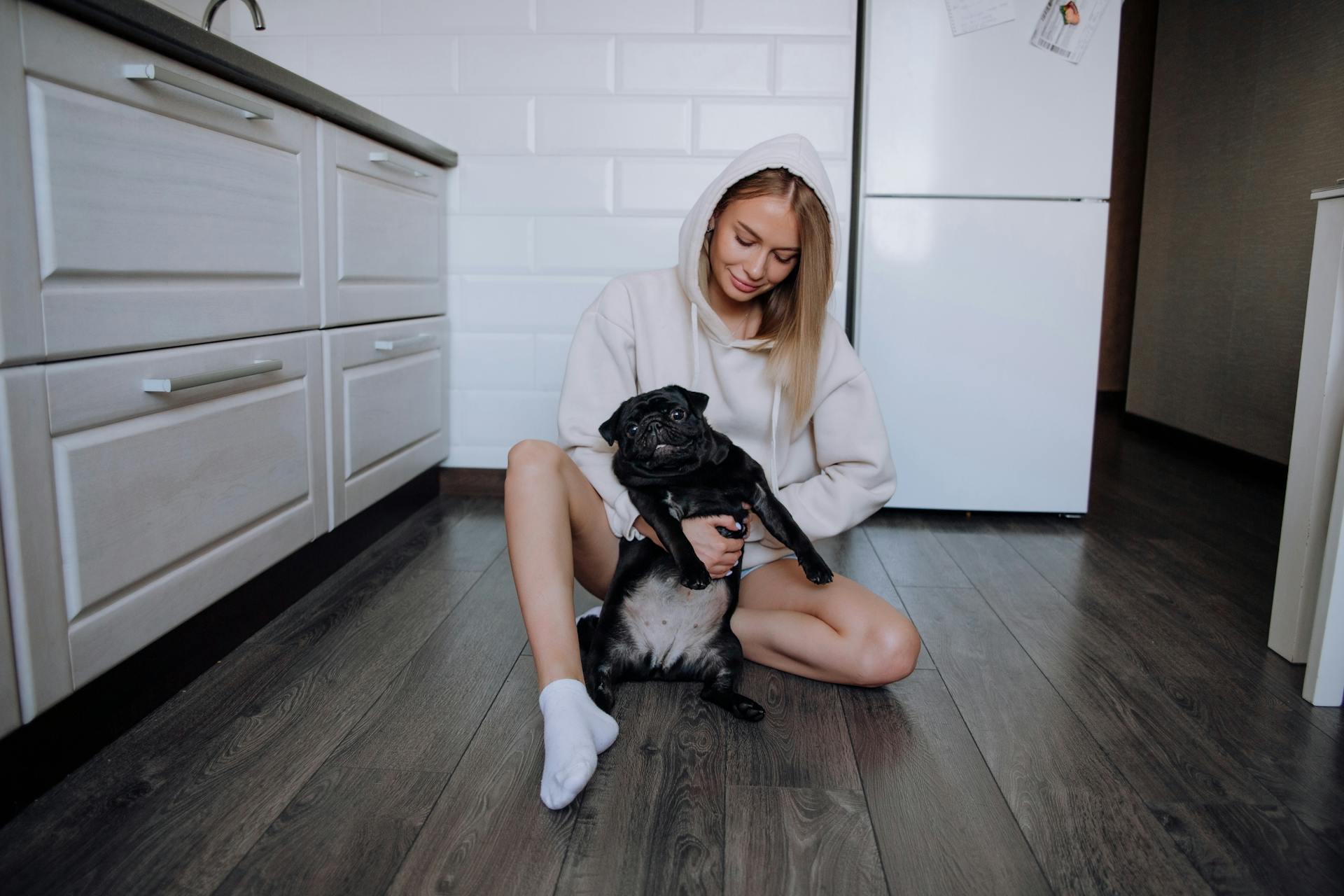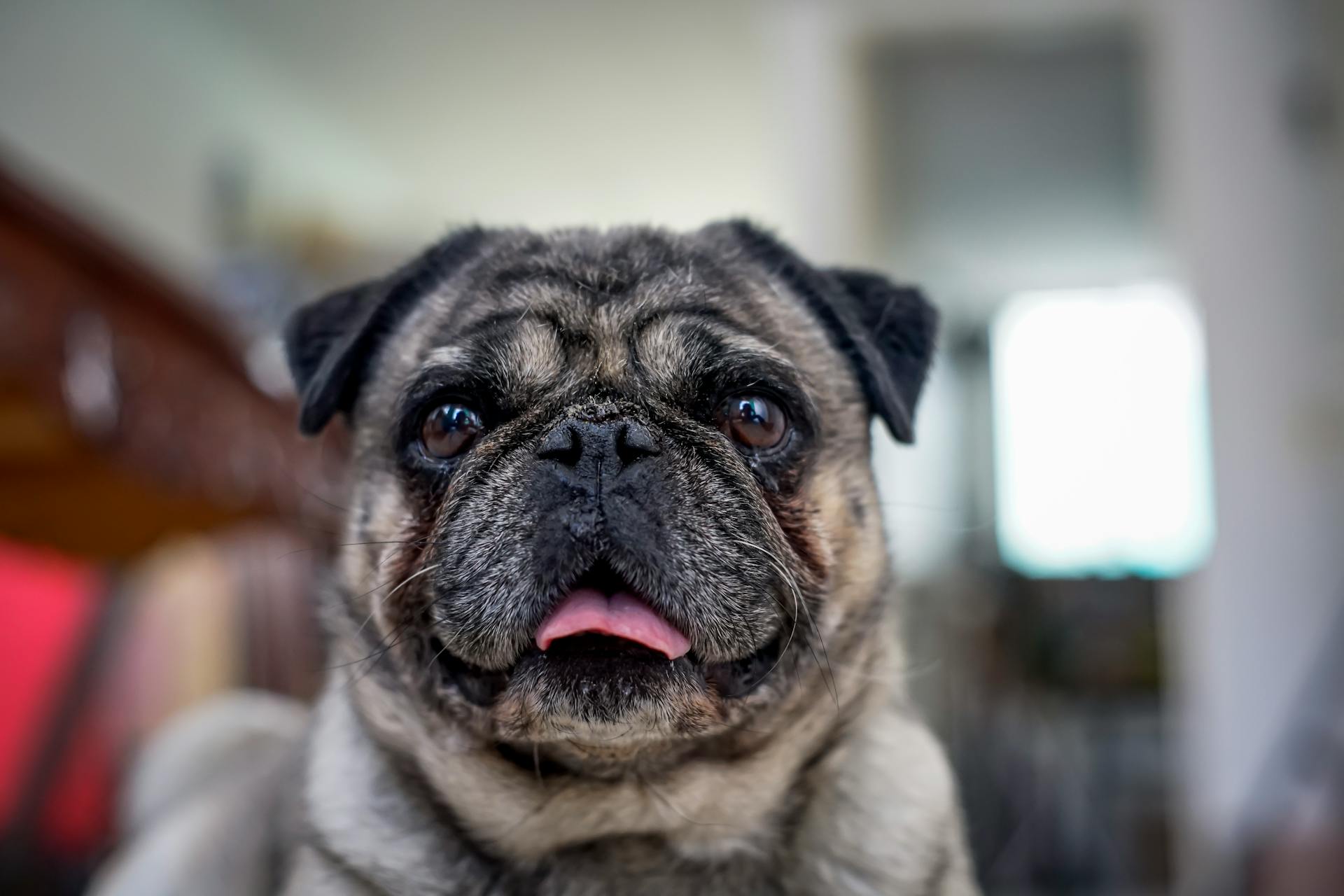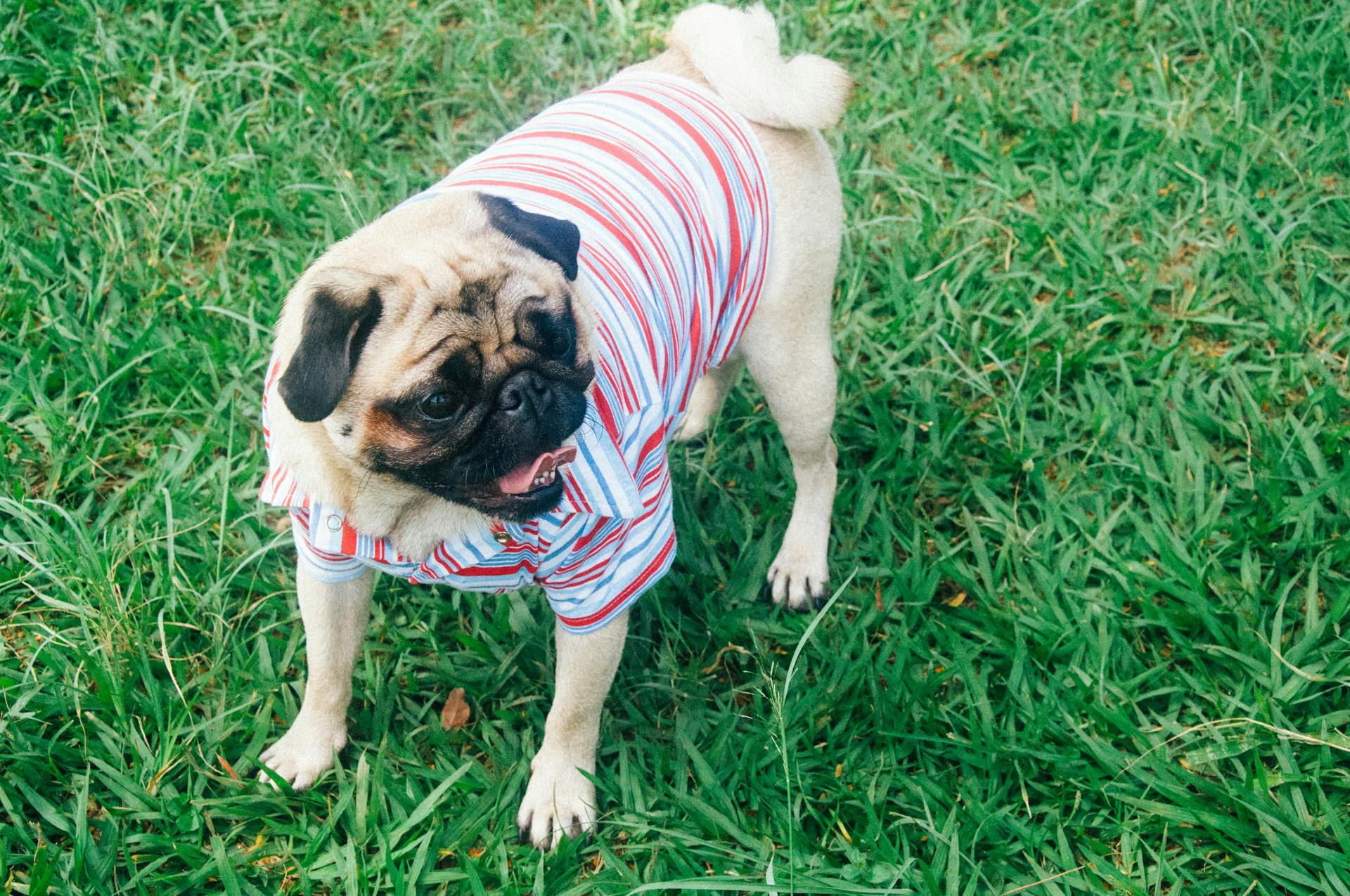
Pug nose dogs are known for their distinctive flat face and short snout, which is a result of a genetic mutation that occurred over 2,000 years ago in ancient China. This unique feature has led to some interesting characteristics and needs for these adorable dogs.
One of the most notable characteristics of pug nose dogs is their brachycephalic skull structure, which can lead to breathing difficulties and a higher risk of heatstroke. They require regular breaks and shade to prevent overheating.
Their flat face also affects their sense of smell, which is less sensitive compared to other breeds. However, their strong sense of hearing and intuition makes up for it.
Pug nose dogs are generally small in size, with adults weighing between 10-17 pounds and standing about 10-13 inches tall.
Physical Characteristics
The Pug's physical characteristics are quite unique and adorable. Their smooth and glossy coats can be fawn, apricot fawn, silver fawn, or black.
Their markings are clearly defined and there is a trace of a black line extending from the occiput to the tail. This distinctive marking is a key feature of the Pug breed.
Pugs have a square cobby body, a compact form, a deep chest, and well-developed muscle. This sturdy build is a result of careful breeding to emphasize the breed's physical characteristics.
Their muzzle is blunt and very short, giving a square-shaped appearance to the head. This distinctive facial feature is a defining characteristic of the Pug breed.
Pugs have two distinct ear shapes, "rose" and "button". The "button" style is the preferred ear shape in breeding.
Their legs are strong, straight, of moderate length, and are set well under the body. This athletic build allows Pugs to move with ease and agility.
Curious to learn more? Check out: How Much Does a Pug Dog Cost
Health Considerations
Pugs are prone to a range of health issues due to their unique physical characteristics. These issues can be attributed to their brachycephalic (flat-faced) skull structure, which can cause respiratory problems, eye issues, and skin fold infections.
The brachycephalic airway syndrome (BAS) is a common issue in pugs, characterized by narrowed nostrils, elongated soft palates, and a narrowed windpipe. This can lead to respiratory symptoms such as noisy breathing, snoring, and labored breathing.
Pugs are also more susceptible to overheating due to their compromised airways, which can make them highly susceptible to heatstroke. It's essential to keep them in a cool environment, avoid strenuous exercise in hot weather, and limit exposure to stress.
In addition to respiratory issues, pugs are prone to dental problems, including crowded teeth and misaligned jaws, which can lead to dental disease. Regular dental care, such as teeth brushing at home and professional cleanings, can help maintain oral health.
Pugs can also experience gastrointestinal issues, including gastric reflux and regurgitation, which can be alleviated by feeding them smaller, more frequent meals and using medications to help with reflux.
Exercise limitations are crucial for pugs, as they should avoid strenuous exercise due to their compromised respiratory systems. Overexertion can quickly lead to exhaustion and respiratory distress.
Here's a summary of common health issues in pugs:
- Brachycephalic airway syndrome (BAS)
- Overheating and heatstroke
- Dental disease
- Gastrointestinal issues (gastric reflux and regurgitation)
- Exercise intolerance and potential obesity
Pug and French Bulldog
If you're set on bringing home a pug or French Bulldog, you'll want to start by checking shelters and breed-specific rescues for your preferred breed. These adorable flat face breeds can make wonderful companions, but they do require some special care.
First, you'll need to find a responsible dog breeder. Take our checklist with you as you visit different breeders, and be prepared to walk away if they don't meet all the minimum criteria.
Your chosen flat face breed will need special attention to stay healthy and happy. This includes daily/weekly wrinkle and skin fold cleaning, extra veterinary costs and visits for common health problems, and short, gentle walks to avoid heatstroke.
French Bulldogs, in particular, are adaptable to various living environments and are suitable for both city apartments and suburban homes. They're a relatively low-energy breed, enjoying short bursts of playtime but also content to relax with their family.
Here are some key things to consider when bringing home a pug or French Bulldog:
- Daily/weekly wrinkle and skin fold cleaning.
- Extra veterinary costs and visits.
- Short, gentle walks and cooling products.
- Help with stairs and jumping on and off furniture.
Etymology and History
The origin of the name "pug" is a topic of interest. Some sources suggest it's derived from the Latin "pugnus" meaning "fist", possibly due to the breed's early cropping, which resulted in a head resembling the shadow of a closed fist.
The Oxford English Dictionary offers another theory, stating that the term "pug" has been used in English since the late 16th century to describe various animals, including squirrels, hares, and monkeys. This etymology is supported by the first attestation of "Pug-dog" in 1749.
The breed's name may also be related to a now obsolete term of endearment for a person or animal, as noted by the Oxford English Dictionary.
Worth a look: Life Span of a Puggle Dog
Etymology
The origin of the name "pug" is a topic of debate. Several theories exist, but no consensus has been reached.
One theory suggests the breed was named after the marmoset monkey, a popular exotic pet during the 18th century, also known as the "Pug-monkey". This is because the Pug's flat face resembles that of a primate.

Another theory proposes the name "pug" is derived from the Latin "pugnus" meaning "fist". This is because early Pugs were commonly cropped, resulting in a head that resembled the shadow of a closed fist when viewed from the side.
The Oxford English Dictionary has the word "pug" as in the dog breed being descended from the meaning of "A dwarf animal, an imp, etc.". This is an interesting connection, as the term "pug" has been used in English to describe various animals, such as squirrels, hares, foxes, ferret, salmon, sheep, and monkeys, since the late 16th century.
The first attestation of "Pug-dog" is in 1749, according to the Oxford English Dictionary.
Historical Depictions
Historical depictions of Pugs can be found in various forms of art and literature from the 18th to the 20th century.
A Dutch Mastiff, known as 'Old Vertue', was depicted with Dunham Massey in the background by Jan Wyck in 1700. This painting showcases the early history of Pug depictions.

Princess Ekaterina Golitsyna was painted by Louis-Michel van Loo in 1759, and the Pushkin Museum of Fine Arts in Moscow still holds this portrait today.
Children of the Marquis de Béthune were shown with a Pug in a painting from 1761, highlighting the popularity of Pugs among the aristocracy.
A male Pug was depicted in 1802, likely showcasing the breed's characteristics during this time period.
In Jane Austen's 1814 novel, Mansfield Park, Lady Bertram, the hero's mother, owned a pet Pug and was more concerned with her Pug's well-being than her children's.
The book "The Dog in Health and Disease" from 1859 featured an engraving of two Pugs, "Punch and Tetty", which demonstrates the breed's presence in literature.
A Pug from 1915 was also documented, showing the breed's evolution over time.
Here are some notable historical depictions of Pugs:
- A Dutch Mastiff (called 'Old Vertue') with Dunham Massey in the Background (Jan Wyck, 1700)
- A portrait of Princess Ekaterina Golitsyna by Louis-Michel van Loo (1759)
- Children of the Marquis de Béthune with a Pug, 1761
- A male Pug, 1802
- Portrait of Sylvie de la Rue, circa 1810
- Young Lady in a Boat with a Pug by James Tissot, 1870
- Engraving of the Pugs "Punch and Tetty" from the 1859 book "The Dog in Health and Disease"
- Pug from 1915
- Pug photo, ca 1900. Note its small head and long legs.
- A Pug by Carl Reichert. (1836–1918)
Frequently Asked Questions
What is a pugs nose condition?
Pugs are prone to breathing difficulties due to their short-nosed skull shape, leading to chronic respiratory distress. This condition can be life-threatening if left untreated.
How to tell if a pug is purebred?
To determine if a Pug is purebred, look for thick, strong legs, a rounded body, deep facial wrinkles, and distinctive cheek moles. A purebred Pug's physical characteristics are a key indicator of its authenticity.
Featured Images: pexels.com


